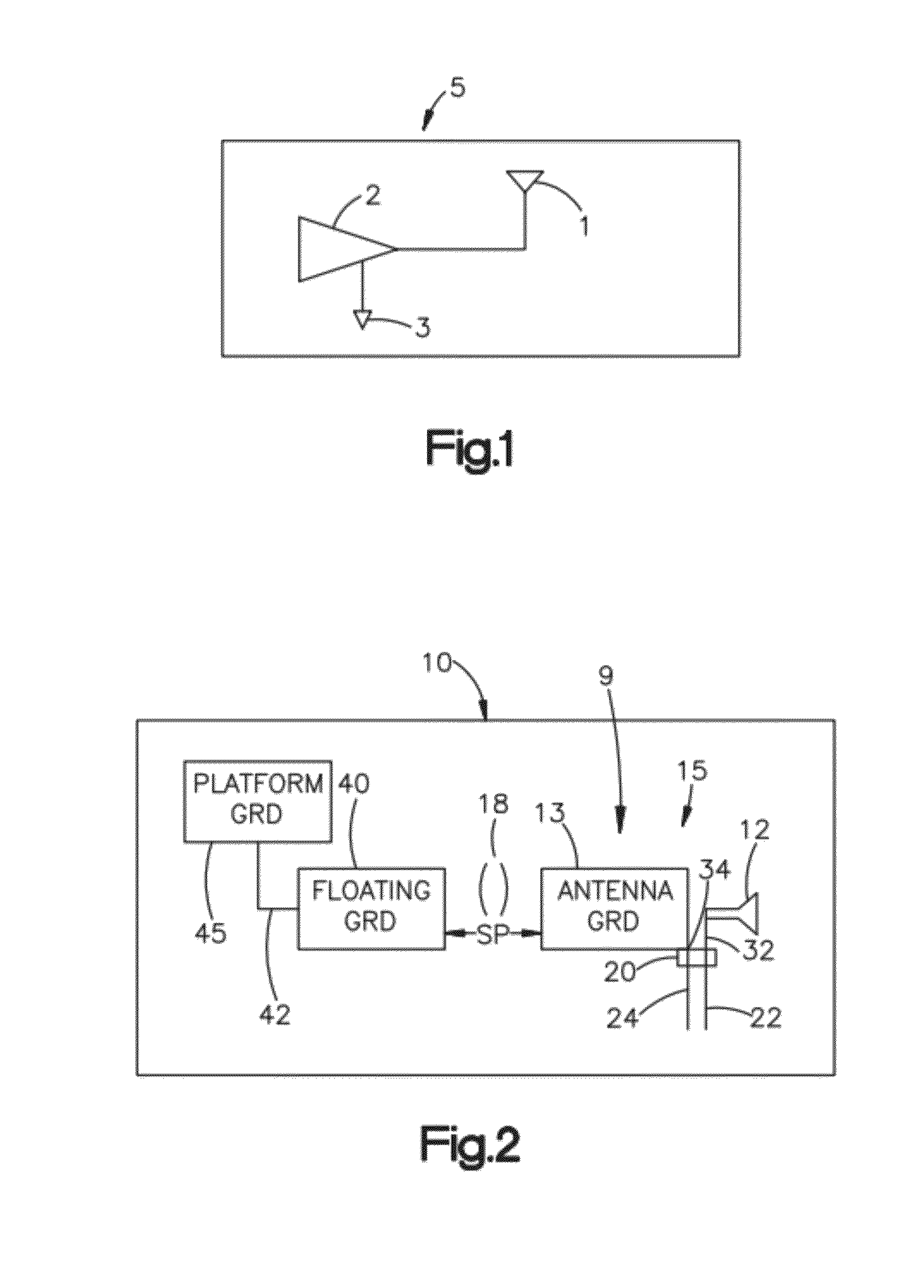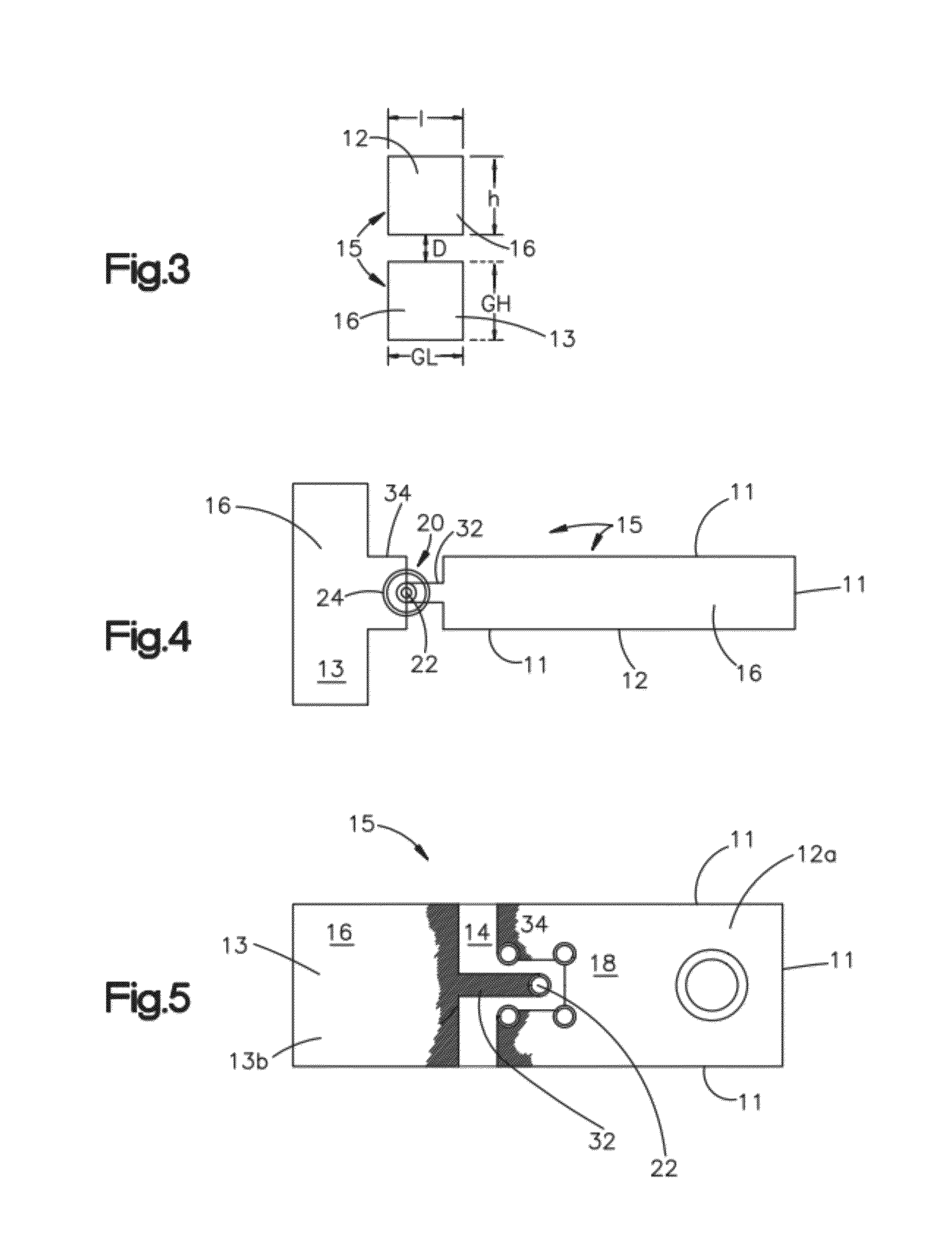Omni-directional antenna system for wireless communication
a wireless communication and omni-directional technology, applied in the structural form of the antenna, the the structure of the antenna, etc., can solve the problems of reducing affecting the service life of the user, so as to reduce the loss and reduce the exposure of the user
- Summary
- Abstract
- Description
- Claims
- Application Information
AI Technical Summary
Benefits of technology
Problems solved by technology
Method used
Image
Examples
example 1
[0079]An Example of a practical application of the antenna system 9 of FIG. 2 for a wirelessly controlled robot 60 is shown in FIGS. 11 and 12. The wirelessly controlled robot 60 includes a circularly polarized antenna 65. The design of antenna 65 is schematically illustrated in FIG. 3 and shown generally in FIG. 5 wherein the radiating element 12 is approximately 25 mm in length l and about 20 mm in height h or width, while the antenna ground 13 is about 115 mm in length GL and about 55 mm in height GH or width, with the radiating element 12 being separated from the antenna ground 13 by about 5 mm (d about 5 mm). The radiating element 12 and antenna ground 13 are formed on the same circuit board or insulating substrate 14, where both the radiating element and antenna ground are relatively flat, thin, planar surfaces oriented in the same plane. In one embodiment, the antenna 65 is mounted about 12.5 mm behind the robot 60 (SP about 12.5 mm), and in this example behind the vertical p...
example 2
[0083]In another example, the same CP antenna 65 as used in the first example on the robot platform 60 was used on the same robot platform but the antenna 65 was mounted 25.4 mm (about 1 inch) behind the robot, e.g., behind the vertical plane of the robot and thus about 25.4 mm from the floating ground plane 90 or wire mesh 91. Again the antenna 65 preferably is mounted to the robot platform 60 so that it is isolated from and not electrically connected to the platform 60. The VSWR for the robot 60 with the CPA antenna 65 mounted 25.4 mm behind the robot (i.e., 25.4 mm from the floating ground plane) is shown in FIG. 15, while the antenna gain at 2.556 GHz is shown in FIG. 16. For the robot 60 with the CPA antenna 65 mounted 25.4 mm from the robot platform (the copper mesh), the VSWR is better than 2:1 from 1.6 GHz to 2.65 GHz as shown in FIG. 15. It should be noted that with the antenna mounted in the back of the robot 60, the gain is maximized behind the robot with the gain ranging...
example 3
[0084]In another example, an antenna 115 schematically illustrated as in FIG. 3, and similar in layout to FIG. 5, has a radiating element 12 having a length l of about 250 mm, and a height h or width of about 180 mm, separated a distance d of about 5 mm from antenna ground 13 is utilized. The antenna ground 13 has a length GL of about 990 mm and a height GH or width of about 990 mm. Both the radiating element 12 and antenna ground 13 are formed on a printed circuit board using printed circuit board technology. Thus, both the radiating element and the antenna ground are formed as thin metal foils or conductive coatings on an insulating substrate 14. Both the radiating element 12 and antenna ground 13 are relatively flat, thin, planar surfaces oriented in the same plane. Circularly polarized antenna 115 is mounted on a moveable vehicle 110 as shown in FIG. 17. The antenna 115 is mounted about an inch behind the vehicle 110. Preferably the antenna is mounted so that it is electrically ...
PUM
 Login to View More
Login to View More Abstract
Description
Claims
Application Information
 Login to View More
Login to View More - R&D
- Intellectual Property
- Life Sciences
- Materials
- Tech Scout
- Unparalleled Data Quality
- Higher Quality Content
- 60% Fewer Hallucinations
Browse by: Latest US Patents, China's latest patents, Technical Efficacy Thesaurus, Application Domain, Technology Topic, Popular Technical Reports.
© 2025 PatSnap. All rights reserved.Legal|Privacy policy|Modern Slavery Act Transparency Statement|Sitemap|About US| Contact US: help@patsnap.com



